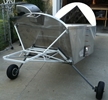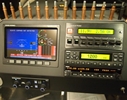


random user submitted photo
Wing Leading Edge Using #31 Drill Bit
7 posts
• Page 1 of 1
Wing Leading Edge Using #31 Drill Bit
I’ve seen posts about using a #32 drill/Deburr/Dimple, but has anyone used a #31 bit instead?
I’m trying to test out both #32 and #31 right now. I’m using the Sonex simple die.
As has been noted, an 1/8” cleco is really (too?) tight. So far, I’m leaning toward the #31 but interested if anyone had issues going that route.
I’m trying to test out both #32 and #31 right now. I’m using the Sonex simple die.
As has been noted, an 1/8” cleco is really (too?) tight. So far, I’m leaning toward the #31 but interested if anyone had issues going that route.
- geotheo
- Posts: 5
- Joined: Sat Nov 12, 2016 2:30 pm
Re: Wing Leading Edge Using #31 Drill Bit
My notes show that for the Sonex dimple die for CCC-4x rivets, I use a #32 drill, 25psi on my Harbor Freight riveter, and dimple the 0.025" sheets individually. As the nail gets burred up from use in the riveter, the burrs can make the nail hard to push into the #32 hole. That's when I use a new nail. I like the snug fit of the 1/8 clecos after the dimple die stretches out the hole.
#31 may work but, with the forces conforming the leading edge to the forward ribs, I did not want to chance having some 1/8 clecos fail to grab their hole.
Paul
#31 may work but, with the forces conforming the leading edge to the forward ribs, I did not want to chance having some 1/8 clecos fail to grab their hole.
Paul
- thomas
- Posts: 59
- Joined: Sat Aug 27, 2016 9:45 am
Re: Wing Leading Edge Using #31 Drill Bit
Ah! Good point when re-clecoing, thanks Paul!
geo
geo
- geotheo
- Posts: 5
- Joined: Sat Nov 12, 2016 2:30 pm
Re: Wing Leading Edge Using #31 Drill Bit
What size drill bit is best ?? Experiment to find out. Objective is to end up with a hole that is close to the size of the rivet AFTER using the dimple die. When I built mine 10 years ago the Sonex dimple die had too steep an angle and stretched the hole way out of shape leaving it much too large. Ended up making my own dimple die and that worked well with the #32 bit. Hopefully Sonex has corrected the design of their dimple die by now. Most 1/8" clecos will fit a #32 hole, but it is a tight fit. Making a new dimple die is easy if you have access to even a cheap little bench top lathe. Found that the end of a common 118 deg. drill bit made the perfect female die. with about 115 degrees on the make die.
David A.
David A.
- DCASonex
- Posts: 935
- Joined: Mon Sep 12, 2011 8:04 pm
- Location: Western NY USA
Re: Wing Leading Edge Using #31 Drill Bit
Drill with #40, dimple with 3/32 dimple dies, then updrill to #32.
Robert
N157SX
Robert
N157SX
-

rbarber - Posts: 107
- Joined: Sat Mar 10, 2012 5:47 pm
Wing Leading Edge Using #31 Drill Bit
Thanks all, I really appreciate all the feedback. I usually don’t take unproven chances on something like this, but in this case for whatever reason…
I decided to go the #31 drill path. Time will tell if I made the right decision and I will report back with results after riveting is complete. At least it may help other builders with the same question.
Sent from my iPhone using Tapatalk
I decided to go the #31 drill path. Time will tell if I made the right decision and I will report back with results after riveting is complete. At least it may help other builders with the same question.
Sent from my iPhone using Tapatalk
- geotheo
- Posts: 5
- Joined: Sat Nov 12, 2016 2:30 pm
Re: Wing Leading Edge Using #31 Drill Bit
For me, the #31 bit worked well and I’m happy with the results.
After non-exhaustive Initial tests using both #31 and #32, in my case it showed the #31 had the more consistent dimple and flush rivet head while maintaining good hold. It also clecoed well pre- and post- dimple.
I finally got around to dimpling and riveting the leading edge on my left wing and the results proved out initial tests.
Having said this, there are so many variables that come into play - tolerance of drill bit, dimple die used (I did NOT use the simple dimple die in this case in order to maintain consistency in dimple),variability in hand pressure for dimple, pressure setting of riveter (I kept mine high at 80 psi), etc. The stack up worked in my favor.
Hopefully this will help others considering using #31 vs. #32 drill bits. #31 is viable but I would recommend you perform simple initial tests similar to what I did and verify you’re satisfied with the results.
Thanks again for all the helpful responses!
geo
After non-exhaustive Initial tests using both #31 and #32, in my case it showed the #31 had the more consistent dimple and flush rivet head while maintaining good hold. It also clecoed well pre- and post- dimple.
I finally got around to dimpling and riveting the leading edge on my left wing and the results proved out initial tests.
Having said this, there are so many variables that come into play - tolerance of drill bit, dimple die used (I did NOT use the simple dimple die in this case in order to maintain consistency in dimple),variability in hand pressure for dimple, pressure setting of riveter (I kept mine high at 80 psi), etc. The stack up worked in my favor.
Hopefully this will help others considering using #31 vs. #32 drill bits. #31 is viable but I would recommend you perform simple initial tests similar to what I did and verify you’re satisfied with the results.
Thanks again for all the helpful responses!
geo
- geotheo
- Posts: 5
- Joined: Sat Nov 12, 2016 2:30 pm
7 posts
• Page 1 of 1
Who is online
Users browsing this forum: No registered users and 17 guests







